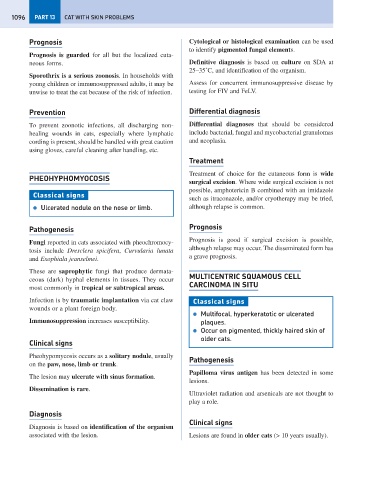Page 1104 - Problem-Based Feline Medicine
P. 1104
1096 PART 13 CAT WITH SKIN PROBLEMS
Prognosis Cytological or histological examination can be used
to identify pigmented fungal elements.
Prognosis is guarded for all but the localized cuta-
neous forms. Definitive diagnosis is based on culture on SDA at
25–35˚C, and identification of the organism.
Sporothrix is a serious zoonosis. In households with
young children or immunosuppressed adults, it may be Assess for concurrent immunosuppressive disease by
unwise to treat the cat because of the risk of infection. testing for FIV and FeLV.
Prevention Differential diagnosis
To prevent zoonotic infections, all discharging non- Differential diagnoses that should be considered
healing wounds in cats, especially where lymphatic include bacterial, fungal and mycobacterial granulomas
cording is present, should be handled with great caution and neoplasia.
using gloves, careful cleaning after handling, etc.
Treatment
Treatment of choice for the cutaneous form is wide
PHEOHYPHOMYOCOSIS
surgical excision. Where wide surgical excision is not
possible, amphotericin B combined with an imidazole
Classical signs
such as itraconazole, and/or cryotherapy may be tried,
● Ulcerated nodule on the nose or limb. although relapse is common.
Pathogenesis Prognosis
Fungi reported in cats associated with pheochromocy- Prognosis is good if surgical excision is possible,
tosis include Dresclera spicifera, Curvularia lunata although relapse may occur. The disseminated form has
and Exophiala jeanselmei. a grave prognosis.
These are saprophytic fungi that produce dermata-
ceous (dark) hyphal elements in tissues. They occur MULTICENTRIC SQUAMOUS CELL
most commonly in tropical or subtropical areas. CARCINOMA IN SITU
Infection is by traumatic implantation via cat claw Classical signs
wounds or a plant foreign body.
● Multifocal, hyperkeratotic or ulcerated
Immunosuppression increases susceptibility. plaques.
● Occur on pigmented, thickly haired skin of
older cats.
Clinical signs
Pheohypomycosis occurs as a solitary nodule, usually Pathogenesis
on the paw, nose, limb or trunk.
Papilloma virus antigen has been detected in some
The lesion may ulcerate with sinus formation.
lesions.
Dissemination is rare.
Ultraviolet radiation and arsenicals are not thought to
play a role.
Diagnosis
Clinical signs
Diagnosis is based on identification of the organism
associated with the lesion. Lesions are found in older cats (> 10 years usually).

